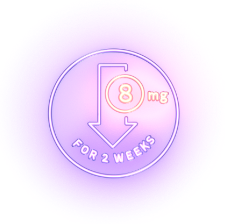IMPORTANT SAFETY INFORMATION & INDICATION
IMPORTANT SAFETY INFORMATION
CONTRAINDICATIONS
TARPEYO is contraindicated in patients with hypersensitivity to budesonide or any of the ingredients
of TARPEYO. Serious hypersensitivity reactions, including anaphylaxis, have occurred with other
budesonide formulations.
WARNINGS AND PRECAUTIONS
Hypercorticism and adrenal axis suppression:
When corticosteroids are used chronically, systemic effects such as hypercorticism and
adrenal suppression may occur. Corticosteroids can reduce the response of the hypothalamus-pituitary-adrenal
(HPA) axis to stress. In situations where patients are subject to surgery or other stress situations,
supplementation with a systemic corticosteroid is recommended. When discontinuing therapy or switching
between corticosteroids, monitor for signs of adrenal axis suppression.
Patients with moderate to severe hepatic impairment (Child-Pugh Class B and C, respectively)
could be at an increased risk of hypercorticism and adrenal axis suppression due to an increased systemic
exposure to oral budesonide. Avoid use in patients with severe hepatic impairment (Child-Pugh Class C).
Monitor for increased signs and/or symptoms of hypercorticism in patients with moderate hepatic impairment
(Child-Pugh Class B).
Immunosuppression and increased risk of infection:
Corticosteroids, including TARPEYO, suppress the immune system and increase the risk of
infection with any pathogen, including viral, bacterial, fungal, protozoan, or helminthic pathogens.
Corticosteroids can: reduce resistance to new infections, exacerbate existing infections, increase the risk
of disseminated infections, increase the risk of reactivation or exacerbation of latent infections, and mask
some signs of infection. Corticosteroid-associated infections can sometimes be serious. Monitor for
infection and consider TARPEYO withdrawal as needed.
Avoid corticosteroid therapy, including TARPEYO, in patients with active or quiescent
tuberculosis or hepatitis B infection; untreated fungal, bacterial, systemic viral, or parasitic
infections; ocular herpes simplex; or Kaposi’s sarcoma. Avoid exposure to active, easily transmitted
infections (e.g., chickenpox, measles). Corticosteroid therapy may decrease the immune response to some
vaccines.
Other corticosteroid effects:
TARPEYO is a systemically available corticosteroid and is expected to cause related
adverse reactions. Monitor patients with hypertension, prediabetes, diabetes mellitus,
osteoporosis, peptic ulcer, glaucoma or cataracts, or with a family history of diabetes or
glaucoma, or with any other condition where corticosteroids may have unwanted effects.
ADVERSE REACTIONS
In clinical studies, the most common adverse reactions with TARPEYO (occurring in ≥5% of
TARPEYO-treated patients, and ≥2% higher than placebo) were peripheral edema (17%), hypertension (12%),
muscle spasms (12%), acne (11%), headache (10%), upper respiratory tract infection (8%), face edema
(8%), weight increased (7%), dyspepsia (7%), dermatitis (6%), arthralgia (6%), and white blood cell
count increased (6%).
DRUG INTERACTIONS
Budesonide is a substrate for CYP3A4. Avoid use with potent CYP3A4 inhibitors, such as
ketoconazole, itraconazole, ritonavir, indinavir, saquinavir, erythromycin, and cyclosporine. Avoid
ingestion of grapefruit juice with TARPEYO. Intake of grapefruit juice, which inhibits CYP3A4
activity, can increase the systemic exposure to budesonide.
USE IN SPECIFIC POPULATIONS
Pregnancy:
The available data from published case series, epidemiological studies, and reviews with
oral budesonide use in pregnant women have not identified a drug-associated risk of major birth defects,
miscarriage, or other adverse maternal or fetal outcomes. There are risks to the mother and fetus
associated with IgAN. Infants exposed to in utero corticosteroids, including budesonide, are at risk for
hypoadrenalism.
INDICATION
TARPEYO is indicated to reduce the loss of
kidney function in adults with primary
immunoglobulin A nephropathy (IgAN) who
are at risk for disease progression.













